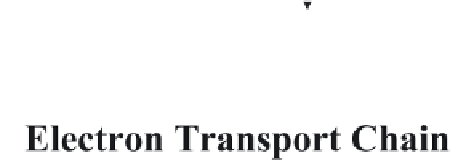Biology Reference
In-Depth Information
Figure 13.1. Schematic representation of events that occur in the mitochondrial inner membrane
during the production of membrane potential.
that exhibit optical and ¯uorescence activity after accumulation in energized
systems [e.g., 3,3
0
-dihexyloxadicarbocyanine iodide, nonyl acridine orange
(NAO), safranine O, rhodamine-123 (Rh123), etc.], radiolabelled probes, (e.g.,
[
3
H]methyltriphenyl-phosphonium, etc.), and unlabelled probes used with spe-
ci®c electrodes [e.g., tetraphenylphosphonium ion ( TPP
), etc.]. These systems
have the following possible disadvantages:
1. time required to achieve equilibrium distribution of a mitochondrial
membrane probe;
2. degree of passive (nonspeci®c) binding of probes to a membrane compo-
nent, as in the case of NAO, which detects mitochondrial mass as it binds
to cardiolipin (Maftah et al., 1990), or Rh123, which has several energy-
independent binding sites ( Lopez-Mediavilla et al., 1989);
3. toxic e¨ects of probes on mitochondrial functional integrity;
4. sampling procedures;
5. interference from light-scattering changes and from absorption changes of
mitochondrial components; and
6. requirement for large amounts of biological materials.
The TPP electrode a¨ords an easy and precise tool to measure Dc owing to
the low interference between bound TPP
and the membrane, and to the elec-
trode lack of response to species other than TPP
. However, this method re-
quires ``discrete'' amounts of biological samples (on the order of several million































































































